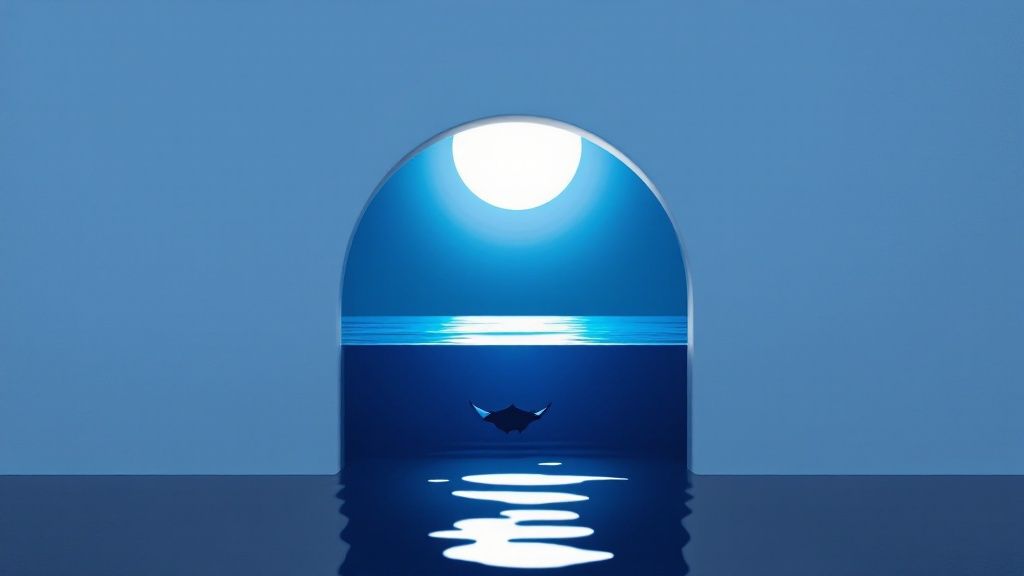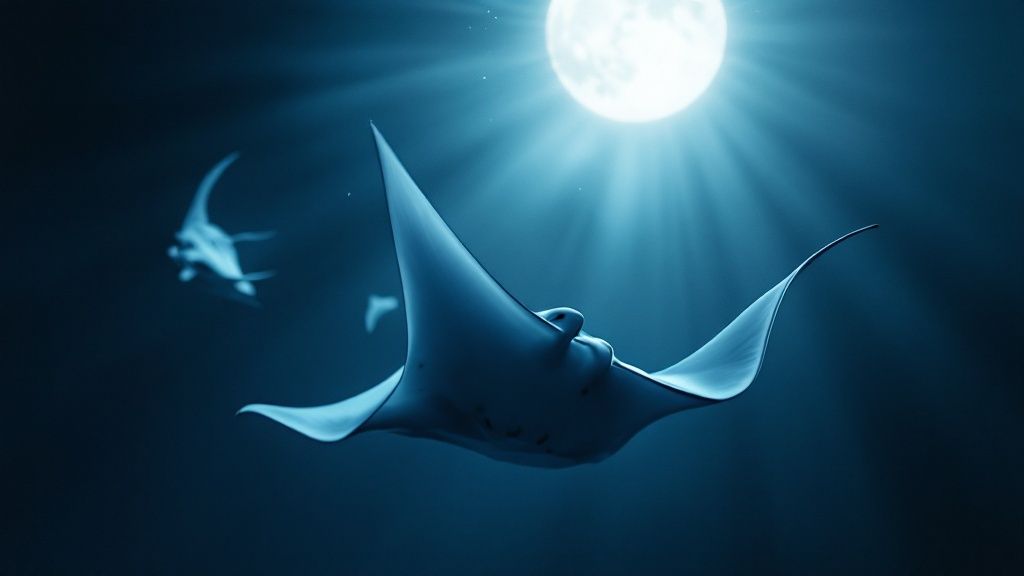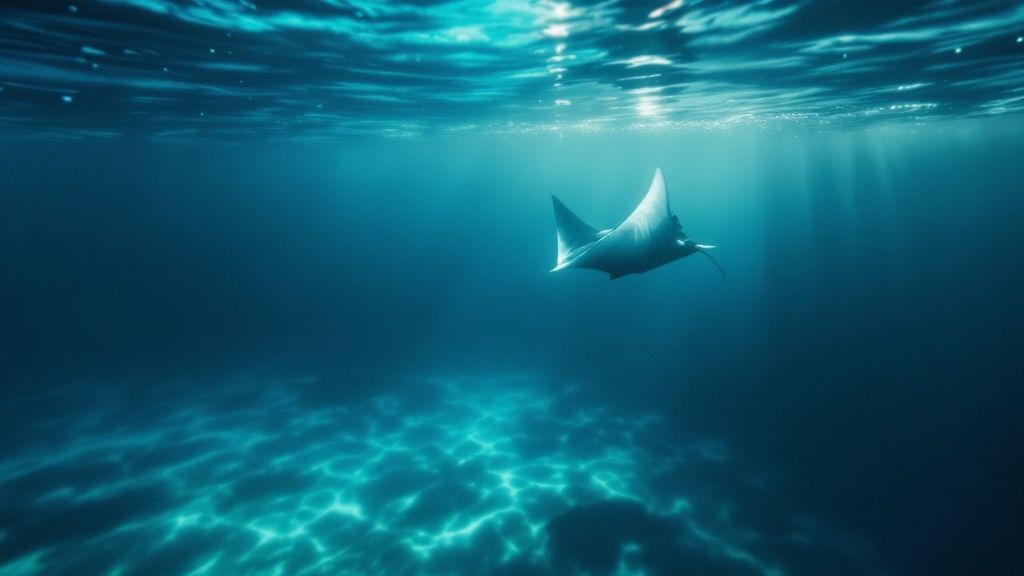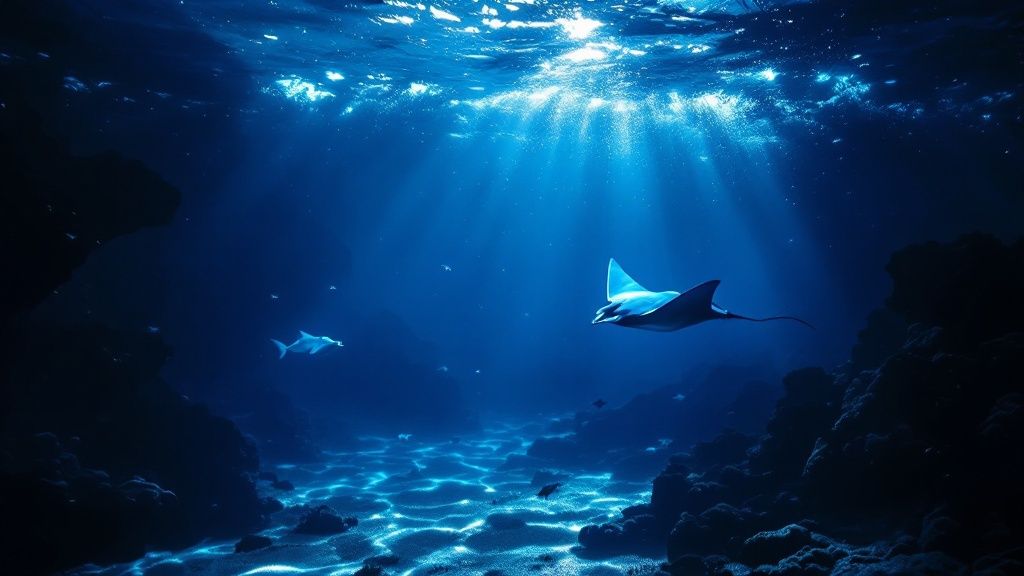Hawaii's Magical Manta Ray Night Snorkel: A Complete Guide
- Byron
- Apr 10
- 10 min read
The Magic Behind Manta Ray Night Snorkeling

There's something truly special about floating in the dark ocean, watching gentle giants glide beneath you. Manta ray night snorkeling offers a unique perspective on these graceful creatures, highlighting their nocturnal feeding habits in a way daytime viewing can't. This experience has become a must-do for visitors to Hawaii.
This popularity stems from the captivating interplay between the manta rays and their environment. The specialized lighting used during these tours isn't just for the snorkelers. It attracts plankton, the manta rays’ main food source, creating a captivating plankton ballet.
This transforms the snorkeling experience into a front-row seat to a mesmerizing natural spectacle. Imagine enormous manta rays, some with wingspans of over 16 feet, performing acrobatic barrel rolls and backflips as they dine on the illuminated plankton. It's a truly unforgettable sight.
Manta ray night snorkeling has gained immense popularity, particularly on the Big Island of Hawaii. By 2015, over 42 commercial tour operators offered this unique experience, boasting an 85-90% success rate for manta ray sightings. This success is due to the unique viewing opportunities offered by nighttime tours and Hawaii's warm, clear waters, which provide an ideal environment for these magnificent creatures. Learn more at the Manta Ray Night Snorkel Blog. Operators like Kona Honu Divers and Captain Cook Snorkeling Tours are thriving thanks to the consistency of these sightings.
Why Choose a Night Snorkel?
Daytime and nighttime manta ray encounters offer distinctly different experiences. While daytime viewing provides glimpses of these creatures gracefully navigating the open ocean, night snorkeling reveals a whole new dimension to their behavior. This focus on feeding habits creates an engaging and educational experience. Check out the Manta Ray Night Snorkel Hawaii Blog Sitemap for more information.
Operators like Manta Ray Night Snorkel Hawaii and Kona Snorkel Trips have refined their operations to enhance this nighttime experience. They utilize strategic lighting and expert guides who share valuable insights into manta ray behavior and the local ecosystem. This combination of natural wonder and expert guidance elevates manta ray night snorkeling from a simple activity to a truly memorable adventure.
Prime Spots for Magnificent Manta Ray Encounters
Hawaii's Kona Coast offers some of the most remarkable manta ray viewing opportunities globally. While many spots offer glimpses of these gentle giants, a few stand out as truly exceptional. Let's explore two world-renowned locations: Makako Bay (Garden Eel Cove) and Keauhou Bay.
Makako Bay (Garden Eel Cove)
Makako Bay, also known as Garden Eel Cove, boasts a shallow, sandy bottom. This environment, rich in plankton, creates a perfect feeding ground for manta rays. The chances of an encounter here are incredibly high; it's almost a guarantee.
Tour operators often enhance the experience with specialized lighting. These lights concentrate plankton, drawing in even more manta rays. This creates a truly mesmerizing spectacle, ideal for seasoned snorkelers and beginners alike.
Keauhou Bay
Keauhou Bay presents a different, yet equally enchanting, manta ray experience. The bay's diverse habitat, featuring both sandy areas and coral reefs, attracts a wealth of marine life. The relatively calm waters make it perfect for families with children or less experienced snorkelers.
Keauhou Bay is known for its resident manta rays, many identified and even named by local researchers. These regular sightings foster a deeper appreciation for these intelligent creatures. The bay's proximity to Kona adds to its accessibility. Approximately 80,000 people participate in manta ray snorkeling and diving activities off the coast of Hawaii each year. Kona Coast locations, especially Makako Bay and Keauhou Bay, remain popular choices. Learn more about the growing manta ray tourism in Hawaii.
For further details about manta rays and other related subjects, check out our sitemap of blog posts.
Choosing the Right Spot
Selecting between Makako Bay and Keauhou Bay depends on a few factors. Water conditions change throughout the year. While both locations offer year-round snorkeling, certain times provide better visibility or calmer seas. Summer often boasts the calmest conditions.
Your snorkeling experience level also matters. Keauhou Bay's calmer waters are generally better for beginners, while Makako Bay might have stronger currents. Finally, research different tour operators, such as Kona Honu Divers, Manta Ray Night Snorkel Hawaii, Kona Snorkel Trips and Captain Cook Snorkeling Tours. Each operator typically prefers specific locations, influencing your snorkeling spot.
To help you make an informed decision, we've compiled a comparison of these two top locations:
To help you decide, take a look at this comparison:
Top Manta Ray Snorkeling Locations in Hawaii: Comparison of the most popular manta ray night snorkeling locations on the Big Island, including success rates, best times, and unique features.
Location | Success Rate | Best Time | Average Number of Mantas | Special Features |
|---|---|---|---|---|
Makako Bay (Garden Eel Cove) | Very High | Year-round, especially summer | 10-20 | Shallow, sandy bottom, ideal for experienced snorkelers, plankton-rich |
Keauhou Bay | High | Year-round, especially summer | 5-15 | Calmer waters, suitable for families and beginners, diverse marine life, resident manta ray population |
As you can see, both locations offer excellent chances of encountering these graceful creatures, each with its own distinct advantages. Choosing the right spot ensures a truly memorable manta ray night snorkel adventure.
Preparing For Your Underwater Manta Adventure

Getting ready for a manta ray night snorkel involves more than just booking a tour. A little pre-trip planning can transform any nerves into excitement. This means thinking about everything from what to pack to how to interact with these amazing creatures.
Gearing Up for the Experience
Packing the right gear is the first step towards a comfortable and enjoyable experience. While Hawaiian waters are warm, a wetsuit is highly recommended for those cooler evenings. Many operators, such as Kona Honu Divers and Captain Cook Snorkeling Tours, provide wetsuits.
Don't forget the essentials for after your swim. A dry towel and a change of clothes for the boat ride back will add to your comfort. If you are prone to seasickness, consider taking preventative measures. Motion sickness medication or patches can help ensure you feel your best. Check out our sitemap for more details on our policies.
Mastering Breathing and Body Position
Getting comfortable with your breathing and body position in the water is key to a successful snorkel. Practicing your breathing techniques in a pool beforehand can increase your confidence. Even just floating and breathing through your snorkel can make a difference.
Maintaining a horizontal body position in the water is crucial. This minimizes splashing and helps you blend in with the environment, respecting the manta rays. Plus, it reduces exertion, allowing you to fully enjoy the experience.
Comfort vs. Complication: Essential Gear
While basic snorkeling gear is a must, a few extra items can improve your comfort. A pool noodle can provide additional buoyancy and stability, allowing you to focus on the manta rays.
However, some items, like underwater cameras, can be more of a hindrance than a help. Unless you’re an experienced underwater photographer, consider leaving the photography to the pros. This lets you fully immerse yourself in the moment. Many operators, including Manta Ray Night Snorkel Hawaii and Kona Snorkel Trips, offer photography packages as part of their tours.
Specialized Wetsuits for Hawaiian Waters
The wetsuits provided by tour operators are often designed specifically for Hawaiian waters. These thinner wetsuits provide more flexibility and comfort in the warm Pacific Ocean.
The material is often chosen for its quick-drying properties. This helps minimize any chill you might feel after getting out of the water, adding to your overall comfort.
Tips for Specific Groups
Photographers: If capturing high-quality images is your goal, consider a dedicated photography tour or private charter. These often offer more flexibility with positioning and time in the water.
Families with Children: Be sure to inform the tour operator about your children's ages and swimming abilities. Some tours are better suited for younger children or less experienced swimmers.
First-Time Snorkelers: Opt for a tour with smaller groups and experienced guides if you’re new to snorkeling. A practice session in a pool or calm water before your tour can also build your confidence.
By focusing on preparation, you can set yourself up for a truly magical manta ray night snorkel. This thoughtful approach ensures you are ready to appreciate the wonder of these gentle giants in their natural habitat.
From Hidden Gem to World-Class Experience

The manta ray night snorkel wasn't always the polished, organized adventure it is today. It evolved from a rare, serendipitous sighting into a must-do Hawaiian activity. This transformation is a testament to the dedication of early pioneers and a growing understanding of these magnificent creatures.
The Early Days of Discovery
The story begins with curious individuals who noticed these gentle giants gathering in the dark. Intrigued by these mysterious encounters, early adventurers started experimenting. They used lights to attract plankton, the manta rays' primary food source, which sparked the initial development of the now-famous manta ray night snorkel.
This organic growth led to more structured tours. Manta ray night snorkeling began gaining traction in Hawaii during the early 1990s. Early tours operated near the Kona Surf Hotel. However, ideal viewing locations shifted to spots like Garden Eel Cove (Makako Bay) and Manta Village. These dedicated sites, along with refined lighting techniques, made the experience more consistent, drawing increasing numbers of enthusiasts. Learn more about this evolution here.
The Role of Science and Conservation
As the manta ray night snorkel's popularity grew, so did the need for responsible practices. Scientists and researchers became key players, studying manta ray behavior and crafting guidelines to minimize disruption. Tour operators collaborated, weaving these scientific findings into their operations.
For example, learning about the sensitivity of manta rays' skin led to strict "no-touch" policies. This collaborative effort resulted in several conservation achievements. Manta ray identification projects, started by tour operator observations, now allow researchers to track individual manta rays, check their health, and gather insights into their life cycle. This data often prompts protective legislation and refined practices for sustainable manta ray night snorkeling, striking a balance between human interaction and wildlife protection.
A Community Effort for Sustainable Tourism
The success of the manta ray night snorkel demonstrates the power of community. The partnership between tour operators like Kona Honu Divers, Manta Ray Night Snorkel Hawaii, Kona Snorkel Trips, and Captain Cook Snorkeling Tours ensures this activity is accessible and environmentally sound.
This shared commitment to sustainability means future generations can also witness these graceful giants. From humble beginnings, the manta ray night snorkel has blossomed into a world-class experience. It celebrates the beauty of nature and the importance of preservation.
Selecting Your Perfect Manta Ray Tour Experience

With so many tour operators offering manta ray night snorkel adventures, picking the right one can make or break your trip. It's important to look past the flashy advertising and focus on the details that truly matter for an unforgettable and ethical experience.
Key Considerations for Tour Selection
The best tour operators prioritize both a fantastic customer experience and the well-being of the manta rays. Here’s what to keep in mind:
Boat Design and Comfort: Think about the boat's size and layout. A smaller boat often leads to a more personalized experience. Look for comfortable seating and easy water access.
Group Size: Smaller groups mean more individual attention from the guides and less disturbance to the manta rays.
Guide Expertise: Knowledgeable guides can greatly enrich your experience, sharing insights into manta ray behavior and the local ecosystem. Look for guides certified in CPR and first aid.
Equipment Quality: Good quality masks, snorkels, fins, and wetsuits are essential for a comfortable and enjoyable snorkel.
Conservation Practices: Choose operators dedicated to sustainable tourism and manta ray protection. Ask about their no-touch policies and other conservation initiatives.
Comparing Top Tour Operators
To help you decide, we've compiled a comparison of a few well-regarded manta ray night snorkel tour providers in Hawaii:
Manta Ray Tour Operator Comparison: Side-by-side comparison of top manta ray night snorkel tour providers in Hawaii
Tour Operator | Price Range | Group Size | Included Equipment | Tour Duration | Additional Features |
|---|---|---|---|---|---|
$100-$150 | 6-12 | Mask, snorkel, fins, wetsuit | 2 hours | Marine life education, underwater photography tips | |
$120-$180 | 10-20 | Mask, snorkel, fins, wetsuit, flotation device | 2.5 hours | Multiple tour times, private charters available | |
$90-$130 | 15-25 | Mask, snorkel, fins, wetsuit | 1.5 hours | Convenient location, short boat ride to snorkel site | |
$110-$160 | 8-16 | Mask, snorkel, fins, wetsuit, underwater flashlight | 2 hours | Experienced guides, focus on manta ray interaction |
As you can see, each tour operator offers slightly different features and price points. Consider what's most important to you – group size, included extras, or tour duration – to make the best choice.
Booking Your Adventure
Booking your manta ray night snorkel in advance is highly recommended, especially during peak season. Many operators offer convenient online booking. Be sure to check their cancellation policies in case of unforeseen weather changes. Most operators provide basic snorkeling gear, including wetsuits. If you prefer your own gear, confirm it's allowed. A personal wetsuit can offer a better fit and added comfort.
Addressing Specific Needs
Whether you're a photography enthusiast, traveling with young children, or a first-time snorkeler, planning ahead will improve your experience:
Photography Enthusiasts: Ask if the tour operator offers photography-focused tours or provides guidance on capturing great underwater shots.
Families with Young Children: Inquire about family-friendly tours with guides experienced with children and appropriately sized equipment.
First-Time Snorkelers: Look for tours that prioritize safety and offer extra support for beginners.
Making an Informed Decision
By considering these factors, you'll be well-prepared to select the perfect manta ray night snorkel experience. This careful planning will ensure a memorable and responsible adventure, leaving you with a deep appreciation for these amazing creatures. Remember, thorough research, including reading reviews and comparing operators, is key to a magical manta ray night snorkel.
The Underwater Ballet: Your Manta Ray Moment
Imagine floating in the dark ocean, the stars shimmering above. Then, a shadow appears, expanding until a 16-foot manta ray gracefully swims below you, its wingtips almost touching your fingers. This is the magic of a manta ray night snorkel.
This unusual experience is emotionally charged. Any initial anxiety about the dark quickly shifts to awe as these gentle giants perform their underwater ballet. This shift, from apprehension to wonder, is common among those who've witnessed this remarkable event. It speaks to the powerful bond we forge with nature in these intimate encounters.
Identifying Individual Mantas
Each manta ray has a unique belly pattern, like a fingerprint. Learning to recognize these patterns lets you identify individual mantas, adding another dimension to the experience. You might even see "Big Bertha," a well-known resident manta famous for her impressive size.
Observing manta ray behavior also offers insight into their comfort levels. Repeated barrel rolls and backflips suggest relaxed feeding, while sudden dives or direction changes might indicate a disturbance. This understanding allows snorkelers to appreciate the nuances of manta ray communication.
The Manta Ray Feeding Frenzy
Manta rays are filter feeders, mainly eating plankton. The special lights used during night snorkels attract plankton, creating a concentrated feast that draws in these magnificent creatures. This has enabled scientists and tour operators to observe specific feeding behaviors unique to these nighttime gatherings.
Manta rays display remarkable agility and intelligence as they navigate the illuminated plankton clouds. Their feeding techniques often involve intricate loops and spirals, maximizing their plankton intake.
A Sensory Symphony Under the Stars
The manta ray night snorkel engages multiple senses. Beyond the stunning visuals, you'll hear the subtle whooshing sounds of the manta rays' wings as they move through the water and feel the gentle currents they create. This immersive experience leaves a lasting impression.
To truly appreciate it, practice mindfulness techniques. Concentrate on your breathing, the cool water, and the surrounding sounds. This presence of mind helps you absorb every detail of these fleeting, unforgettable moments.
Ready to experience the magic? Book your unforgettable Manta Ray Night Snorkel Kona Hawaii Tour today! Learn more and reserve your spot. Our tours are designed for all experience levels, offering a personalized encounter with these gentle giants.
Comments